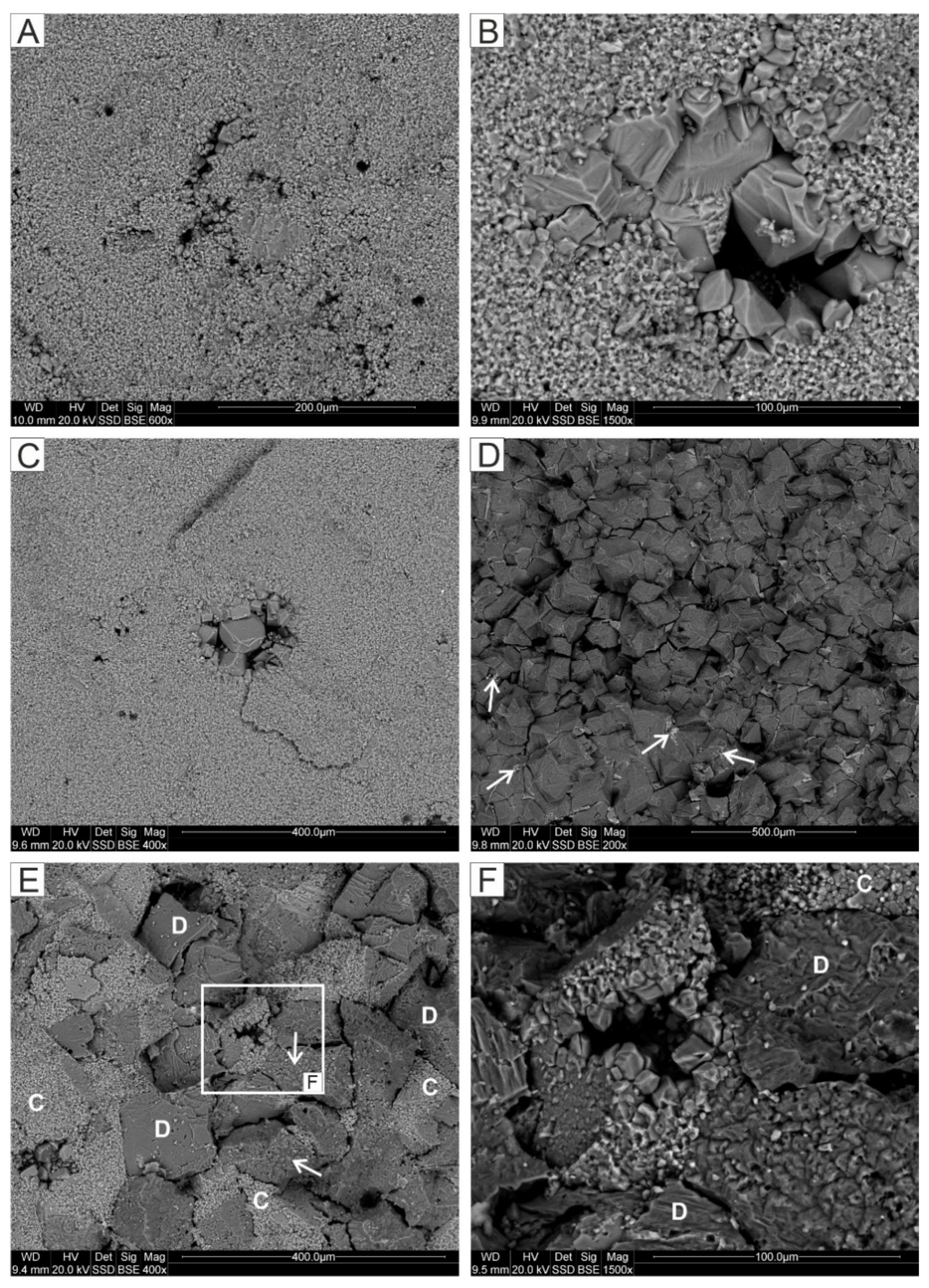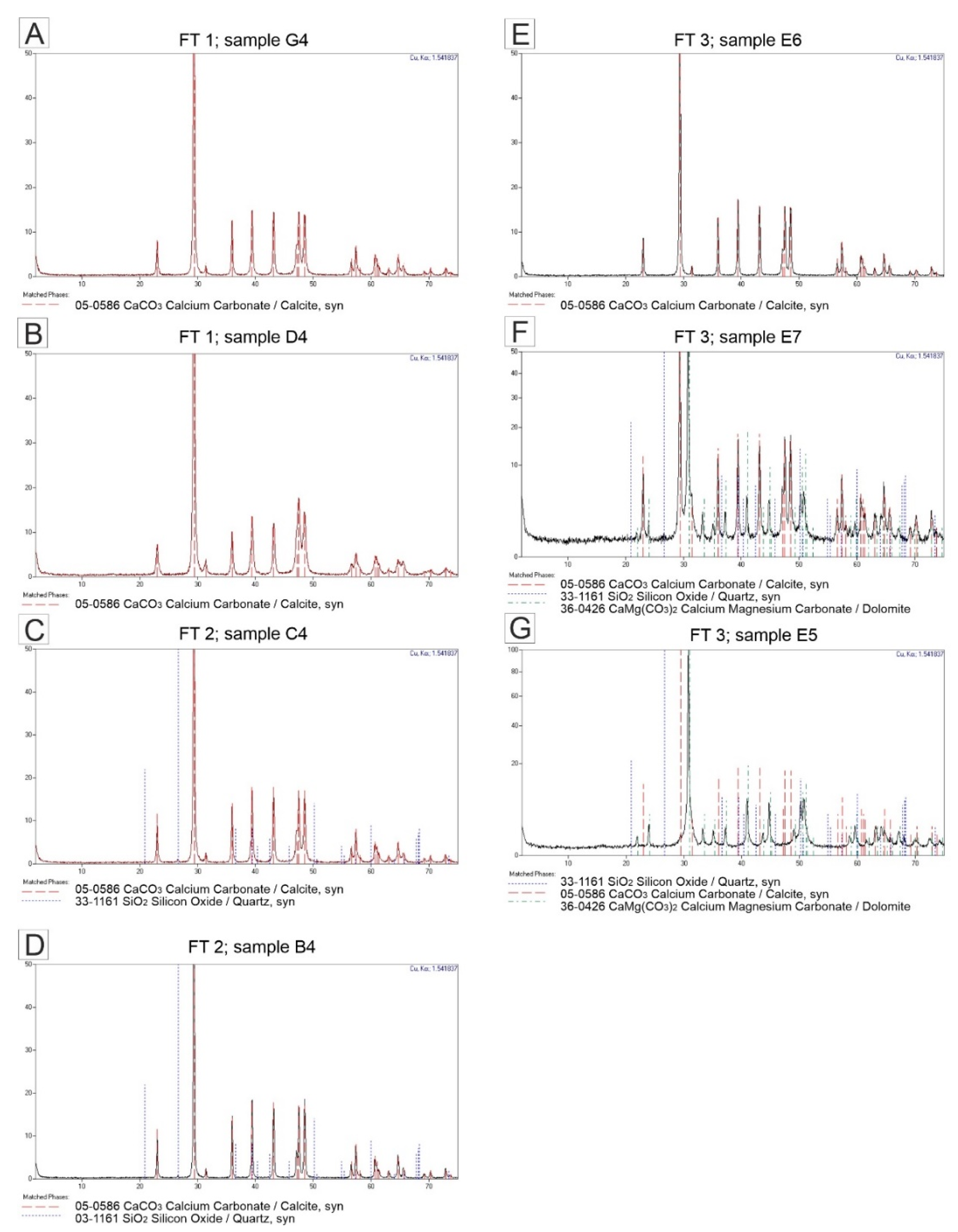Upper Jurassic Bedded Limestones and Early Diagenetic Dolomitized Limestones in the Light of Mineralogical, Geochemical and Sedimentological Studies; Kraków Area, Poland
Abstract
:1. Introduction
2. Geological Setting
3. Materials and Methods
4. Results
4.1. Limestone Facies and Microfacies Analyses
4.2. Geochemical and Mineralogical Analyses of Limestones and Dolomitic Limestones
5. Discussion
5.1. Geochemical and Mineralogical Characterization of Limestone Facies
5.2. Porosity Changes of Limestone Facies Types
5.3. Remarks on Limestones Dolomitization in the Kraków Area
6. Conclusions
Author Contributions
Funding
Institutional Review Board Statement
Informed Consent Statement
Data Availability Statement
Acknowledgments
Conflicts of Interest
References
- Ziegler, P.A. Geological Atlas of Western and Central Europe; Shell Intern Petrol Maatsch BV: Hague, The Netherlands, 1990; pp. 239–256. [Google Scholar]
- Matyszkiewicz, J. Microfacies, sedimentation and some aspects of diagenesis of Upper Jurassic sediments from the elevated part of the Northern peri-Tethyan Shelf, a comprative study on the Lochen area [Schwäbische Alb] and the Cracow area (Cracow-Wielun Upland, Poland). Berl. Geowiss. 1997, Abh. E21, 1–111. [Google Scholar]
- Matyszkiewicz, J. Sedimentation and diagenesis of the Upper Oxfordian limestones in Piekary near Kraków. Ann. Soc. Geol. Pol. 1989, 59, 201–230. [Google Scholar]
- Matyszkiewicz, J.; Kochman, A.; Duś, A. Influence of local sedimentary conditions on development of microbialites in the Oxfordian carbonate buildups from the southern part of the Kraków-Częstochowa Upland (South Poland). Sediment. Geol. 2012, 263–264, 109–132. [Google Scholar] [CrossRef]
- Krajewski, M.; Olchowy, P.; Rudziński, D. Sedimentary successions in the Middle–Upper Oxfordian reef deposits from the southern part of the Kraków–Częstochowa Upland [Southern Poland]. Geol. Quart. 2018, 62, 653–668. [Google Scholar] [CrossRef] [Green Version]
- Lewicka, E.; Szlugaj, J.; Burkowicz, A.; Galos, K. Sources and markets of limestone flour in Poland. Resources 2020, 9, 118. [Google Scholar] [CrossRef]
- Matyszkiewicz, J. Epigenetic silification of the Upper Oxfordian limestones in the vicinity of Kraków. Ann. Soc. Geol. Pol. 1987, 57, 59–87, (In Polish with English summary). [Google Scholar]
- Krajewski, M.; Bajda, T. Mineralogical and geochemical diversification of Upper Jurassic limestones of the Zakrzówek Horst, Kraków region, Southern Poland. Kwart. AGH Geol. 2002, 28, 129–143. [Google Scholar]
- Rutkowski, J. Objaśnienia do Szczegółowej Mapy Geologicznej Polski w skali 1:50000 Arkusz Kraków (973); Państwowy Instytut Geologiczny: Warszawa, Poland, 1993; p. 46. (In Polish)
- Alexandrowicz, S. Turonian of the southern part of the Cracow Upland. Acta Geol. Polon. 1954, 4, 361–390. (In Polish) [Google Scholar]
- Gradziński, R. Geological Guide around Kraków; Wydawnictwo Geologiczne: Warszawa, Poland, 1972. (In Polish)
- Gradziński, R. Geological Map of Krakow Region without Quaternary and Terrestrial Tertiary Deposits; Wydawnictwo Instytutu Nauk Geologicznych PAN: Kraków, Poland, 2009. [Google Scholar]
- Jurkowska, A.; Świerczewska-Gładysz, E. Evolution of Late Cretaceous Si cycling reflected in the formation of siliceous nodules (flints and cherts). Glob. Planet. Chang. 2020, 195, 103334. [Google Scholar] [CrossRef]
- Dżułyński, S. The origin of the Upper Jurassic limestones in the Cracow area. Rocz. Pol. Towarz. Geol. 1952, 21, 125–180. [Google Scholar]
- Kutek, J. Jurassic tectonic events in south-eastern cratonic Poland. Acta Geol. Polon. 1994, 44, 167–221. [Google Scholar]
- Krajewski, M. Upper Jurassic chalky limestones in the Zakrzówek Horst, Kraków-Wieluń Upland, Kraków region, south Poland. Ann. Soc. Geol. Pol. 2001, 71, 43–52. [Google Scholar]
- Gaweł, A. Dolomitisation des calcaires jurassiques des environs de Cracovie. Rocz. Pol. Towarz. Geol. 1948, 19, 292–317, (In Polish with French summary). [Google Scholar]
- Łaptaś, A. The dolomites in the Upper Jurassic limestones in the area of Cracow (Southern Poland). Rocz. Pol. Towarz. Geol. 1974, 34, 247–273, (In Polish with English Summary). [Google Scholar]
- Vierek, A. Upper Jurassic limestone metasomatic processes in the Kraków area. Przegl. Geol. 2003, 51, 507–516, (In Polish with English Summary). [Google Scholar]
- Kochman, A.; Kozłowski, A.; Matyszkiewicz, J. Epigenetic siliceous rocks from the southern part of the Kraków-Częstochowa Upland (Southern Poland) and their relation to Upper Jurassic early diagenetic chert concretions. Sediment. Geol. 2020, 401, 105636. [Google Scholar] [CrossRef]
- Marciniak, H.; Diduszko, R.; Kozak, M. XRAYAN Program do Rentgenowskiej Analizy Fazowej, Wersja 4.2.2; Koma: Warszawa, Poland, 2006. [Google Scholar]
- Gąsiewicz, A. Dedolomityzacja utworów górnojurajskich w okolicy Hedwiżyna (płd. Lubelszczyzna). Przegl. Geol. 1983, 31, 244–247, (In Polish with English Summary). [Google Scholar]
- Leinfelder, R.; Krautter, M.; Laternser, R.; Nose, M.; Schmid, D.; Schweigert, G.; Werner, W.; Keupp, H.; Brugger, H.; Herrmann, R.; et al. The origin of Jurassic reefs: Current research developments and results. Facies 1994, 31, 1–56. [Google Scholar] [CrossRef]
- Olchowy, P.; Krajewski, M.; Felisiak, I. Late Jurassic facies succession of the Kleszczów Graben area (southern border of the Łódz Depression, peri-Tethyan shelf, central Poland). Geol. Quart. 2019, 63, 657–681. [Google Scholar] [CrossRef] [Green Version]
- Kershaw, S. Classification and geological significance of biostromes. Facies 1994, 31, 81–92. [Google Scholar] [CrossRef]
- Bathurst, R.G.C. Carbonate Sediments and their Diagenesis; Elsevier: Amsterdam, The Netherlands, 1975; p. 658. [Google Scholar]
- Shinn, E.A.; Robbin, D.M. Mechanical and chemical compaction in fine-grained shallow-water limestones. J. Sediment. Petrol. 1983, 53, 595–618. [Google Scholar]
- Flügel, E. Microfacies of Carbonate Rocks, Analysis, Interpretation and Application; Springer: Berlin/Heidelberg, Germany, 2004. [Google Scholar]
- Tucker, M.E.; Wright, V.P. Carbonate Sedimentology; Blackwell Science: Oxford, UK, 2004; pp. 1–491. [Google Scholar]
- Matyszkiewicz, J. Sea-bottom relief versus differential compaction in ancient platform carbonates: A critical reassessment of an example from Upper Jurassic of the Cracow-Wieluń Upland. Ann. Soc Geol. Pol. 1999, 69, 63–79. [Google Scholar]
- Moore, C.H. Carbonate Reservoirs, Porosity Evolution and Diagenesis in Sequence Stratigraphic Framework; Elsevier: Amsterdam, The Netherlands, 2001; pp. 1–460. [Google Scholar]
- Matyszkiewicz, J.; Kochman, A. Pressure dissolution features in Oxfordian microbial-sponge buildups with pseudonodular texture, Kraków Upland, Poland. Ann. Soc. Geol. Pol. 2016, 86, 355–377. [Google Scholar] [CrossRef] [Green Version]
- Kochman, A.; Matyszkiewicz, J. Experimental method for estimation of compaction in the Oxfordian bedded limestones of the southern Kraków-Częstochowa Upland, Southern Poland. Acta Geol. Pol. 2013, 63, 681–696. [Google Scholar] [CrossRef] [Green Version]
- Koch, R.; Senowbari-Daryan, B.; Strauss, H. The Late Jurassic “Massenkalk Fazies” of Southern Germany: Calcareous Sand Piles rather than Organic Reefs. Facies 1994, 31, 179–208. [Google Scholar] [CrossRef]
- Reinhold, C. Multiple episodes of dolomitization and dolomite recrystallization during shallow burial in Upper Jurassic shelf carbonates: Eastern Swabian Alb, southern Germany. Sediment. Geol. 1998, 121, 71–95. [Google Scholar] [CrossRef]
- Golonka, J.; Gahagan, L.; Krobicki, M.; Marko, F.; Oszczypko, N.; Ślączka, A. Plate Tectonic Evolution and Paleogeography of the Circum–Carpathian Region. In The Carpathians and Their Foreland: Geology and Hydrocarbon Resources; Golonka, J., Picha, F., Eds.; American Association of Petroleum Geologists: Tulsa, OK, USA, 2006. [Google Scholar]
- Kowal-Kasprzyk, J.; Krajewski, M.; Gedl, P. The oldest stage of the Outer Carpathian evolution in the light of Oxfordian–Kimmeridgian exotic clast studies (southern Poland). Facies 2020, 66, 11. [Google Scholar] [CrossRef] [Green Version]
- Evamy, B.D. Dedolomitization and the development of rhombohedral pores in limestones. J. Sed. Pet. 1967, 37, 1204–1215. [Google Scholar] [CrossRef]
- Al-Hashimi, W.S.; Hemingway, J.E. Recent dedolomitization and the origin of the rusty crusts of Northumberland. J. Sed. Pet. 1973, 43, 82–91. [Google Scholar] [CrossRef]
- Frank, J.R. Dedolomitization in the Taum Sauk limestone (Upper Cambrian), Southeast Missouri. J. Sed. Pet. 1981, 51, 7–18. [Google Scholar]
- Gąsiewicz, A. Dedolomityzacja utworów dolomitu płytowego na Wyniesieniu Łeby. Przegl. Geol. 1986, 34, 257–260, (In Polish with English Summary). [Google Scholar]





| Chemical Composition of Limestones—wt. % | Chemical Composition of Insoluble Residuum—wt.% | ||||||||||||||
|---|---|---|---|---|---|---|---|---|---|---|---|---|---|---|---|
| Sample | FT 1 | FT 2 | FT 3 | Sample | FT 1 | FT 2 | FT 3 | ||||||||
| D2 | G3 | A1 | F2 | B2 | C2 | E4 | D2 | G3 | A1 | F2 | B2 | C2 | E4 | ||
| SiO2 | 0.02 | 0.11 | 0.04 | 0.09 | 0.04 | 0.09 | 0.03 | SiO2 | 84.14 | 70.35 | 84.65 | 75.02 | 86.42 | 88.97 | 68.67 |
| Al2O3 | 0.02 | 0.11 | 0.03 | 0.03 | 0.02 | 0.04 | 0.03 | Al2O3 | 8.69 | 19.89 | 8.39 | 15.41 | 8.53 | 5.98 | 19.3 |
| Fe2O3 | 0.06 | 0.12 | 0.06 | 0.05 | 0.05 | 0.06 | 0.05 | Fe2O3 | 2.41 | 3.57 | 1.29 | 2.6 | 0.91 | 0.88 | 3.22 |
| CaO | 54.15 | 52.71 | 55.08 | 54.7 | 54.69 | 53.07 | 54.92 | CaO | 0.26 | 0.41 | 0.41 | 0.35 | 0.26 | 0.14 | 0.56 |
| MgO | 0.13 | 0.2 | 0.01 | 0.27 | 0.27 | 0.26 | 0.27 | MgO | 1.16 | 0.62 | 1.73 | 2.2 | 0.86 | 0.67 | 3.34 |
| H2O− | 0.21 | 0.01 | 0.12 | 0.02 | 0.01 | 0.01 | 0.01 | H2O− | 0.38 | 0.53 | 0.45 | 0.71 | 0.35 | 0.22 | 0.83 |
| H2O+ | 0.36 | 0.9 | 0.28 | 0.4 | 0.35 | 0.38 | 0.31 | H2O+ | 0.01 | 0.01 | 0.01 | 0.01 | 0.01 | 0.01 | 0.01 |
| LOI | 43.13 | 42.27 | 43.39 | 43.38 | 42.91 | 42.03 | 43.58 | LOI | 0.15 | 0.63 | 0.58 | 0.22 | 0.1 | 0.16 | 0.16 |
| Residuum | 1.59 | 2.79 | 0.93 | 1.35 | 1.67 | 4.79 | 1.62 | Residuum | 1.8 | 2.25 | 1.65 | 2.97 | 2.11 | 1.39 | 3.5 |
| Total | 99.6 | 99.22 | 99.94 | 100.29 | 99.94 | 100.73 | 100.82 | Total | 99 | 98.26 | 99.17 | 99.5 | 99.55 | 98.42 | 99.58 |
| Facies Type | Sample | Phase | wt. % |
|---|---|---|---|
| FT 1 | G4 | Calcite | 100 |
| D4 | Calcite | 100 | |
| FT 2 | C4 | Calcite Quartz | 99.6 0.4 |
| B4 | Calcite Quartz | 99.4 0.6 | |
| FT 3 | E7 | Dolomite Calcite Quartz | 52.4 47.4 0.2 |
| E5 | Dolomite Calcite Quartz | 98.6 1.4 0.1 | |
| E6 | Calcite | 100 |
Publisher’s Note: MDPI stays neutral with regard to jurisdictional claims in published maps and institutional affiliations. |
© 2021 by the authors. Licensee MDPI, Basel, Switzerland. This article is an open access article distributed under the terms and conditions of the Creative Commons Attribution (CC BY) license (https://creativecommons.org/licenses/by/4.0/).
Share and Cite
Krajewski, M.; Olchowy, P. Upper Jurassic Bedded Limestones and Early Diagenetic Dolomitized Limestones in the Light of Mineralogical, Geochemical and Sedimentological Studies; Kraków Area, Poland. Minerals 2021, 11, 462. https://doi.org/10.3390/min11050462
Krajewski M, Olchowy P. Upper Jurassic Bedded Limestones and Early Diagenetic Dolomitized Limestones in the Light of Mineralogical, Geochemical and Sedimentological Studies; Kraków Area, Poland. Minerals. 2021; 11(5):462. https://doi.org/10.3390/min11050462
Chicago/Turabian StyleKrajewski, Marcin, and Piotr Olchowy. 2021. "Upper Jurassic Bedded Limestones and Early Diagenetic Dolomitized Limestones in the Light of Mineralogical, Geochemical and Sedimentological Studies; Kraków Area, Poland" Minerals 11, no. 5: 462. https://doi.org/10.3390/min11050462






